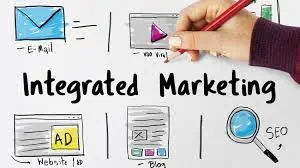
If you’re a small business, you might not be familiar with integrated marketing campaigns. Still, it’s a powerful marketing strategy that can help companies generate more traffic, engagement, and sales. Since marketing changes with technological advances, it’s important to embrace different marketing trends and tactics like integrated marketing campaigns and the closely related multi-channel attribution and omnichannel marketing tactics. So, what is an integrated marketing campaign? In this article, we’ll answer that question and share the benefits of integrated marketing campaigns, best practices, how to create an integrated marketing campaign, and some of our favorite examples of integrated marketing campaigns.
What Is an Integrated Marketing Campaign?
An integrated marketing campaign involves different marketing channels to promote your products or services. These marketing campaigns help align your brand messaging to ensure consistent delivery across marketing channels and assets. While the term “integrated marketing” is sometimes used interchangeably with “omnichannel marketing” or “multi-channel marketing,” integrated marketing focuses on consistent messaging across platforms. In contrast, multi-channel marketing targets different segments on different marketing channels.
Why Use Integrated Marketing?
Integrated marketing offers several advantages that can make your marketing operation more effective.
Consistent narrative
The typical adult is exposed to more than 350 ads a day, but only about one-third of them attract even a few seconds of attention. I will remember very few of those ads, even a day later.
One way to ensure that your ads and other marketing resources make a lasting impression is to integrate them into a consistent narrative that can implement across multiple channels of delivery. Prospective customers will recall a billboard ad better when its content reminds them of another ad viewed online. And they’ll be even more likely to engage with ads that mirror interactions they may have recently had with your brand on social media.
Improved marketing campaign performance
Greater consistency within your brand’s narrative associated with integrated marketing leads to better overall campaign performance. Companies that lead in marketing results are 1.5 times more likely to have an integrated technology solution that helps them convey the same narrative across all of their channels.
Reduced costs and better value
Integrating your marketing channels can also reduce the costs of creating marketing content by allowing you to reuse the same content across different channels. For example, if you have a brand mascot, you can use images and videos of the mascot in online and offline marketing media.
Similarly, you can distribute the same talking points to sales representatives in different locations or at other events to synchronize your messaging. Practices like these are more effective due to narrative consistency, but they also help reduce your overhead.
Consistent customer experience
It’s not just marketers who benefit from integrated marketing. Customers will also appreciate the consistency and predictability of a unified brand narrative. The added familiarity makes it easier for them to understand what you do and how you can help them. In this respect, integrated marketing goes hand-in-hand with omnichannel marketing to provide the most satisfying customer experiences.
Benefits of Integrated Marketing Campaigns
Why choose an integrated marketing campaign over other types of marketing campaigns? Integrated campaigns are all about targeting your audience using consistent messaging across multiple channels. This gives you more opportunities to meet your audience wherever they are. And the statistics back up the need for integrated marketing campaigns.
According to GE Capital Retail Bank’s second annual Major Purchase Shopper Study, 81% of consumers conduct online research before purchasing. Not only that, but Marketing Week reports that consumers use an average of six touch-points when making a purchase—up from an average of two touch-points 15 years ago. Integrated marketing campaigns are also reported to have 3X higher effectiveness rates (Heinz/PFL 2018 Multichannel Marketing Effectiveness Report)!
When compared with single-channel marketing campaigns, integrated marketing campaigns can help your brand:
Reach a broader audience
Increase brand recall and brand recognition
Build trust through consistency
Balance short-term results with long-term growth
Repurpose content to reduce content creation costs
Of course, more marketing channels also means that your planning and delivery will be more intensive. You’ll have more deadlines to meet, more data to collect, and more data points to analyze. Overall, we believe that integrated marketing campaigns offer many more benefits than disadvantages.
Despite the apparent benefits of integrated marketing campaigns, roughly 55% of companies do not have an integrated marketing strategy. If your company is one of those that aren’t using integrated marketing campaigns, here are some best practices that will help you get started.
Integrated Marketing Campaign: Strategies and Best Practices

Integrated marketing doesn’t mean you run the same ad or publish the same content across marketing channels. It’s much more nuanced than that. After all, you already know that each marketing channel has advantages and disadvantages. Plus, not all marketing channels will reach the same segments of your target market. We’ll be sharing a step-by-step approach to creating an integrated marketing campaign in just a moment. But first, let’s take a minute to talk about three key strategies and best practices to keep in mind when creating your campaigns.
Team Alignment: To get the most from your marketing campaigns, you’ll want to choose marketing channel managers and encourage those managers to talk and share ideas.
Channel Transitions: Integrated marketing campaigns will generate traffic from multiple sources. As such, it’s essential to think about and plan for how each visitor will experience your drive, no matter the channel or route they use to get there.
Cross-Promoting Channels: To avoid overlaps in the coverage of your integrated marketing campaigns, you’ll want to make sure that you’re looking at all marketing channels collectively instead of siloing them. These campaigns need to be cohesive to be effective. This means adding your social media profiles to your promotional emails, adding your website to your social media profiles, embedding social media content on your website, and integrating the share buttons on your website.
Building an Integrated Marketing Campaign
If you’ve never created integrated marketing campaigns before, don’t worry. Here are the steps you can take to ensure that your integrated campaigns hit the mark and deliver the message you want.
1. Set Campaign Goals
As with any strategy, you have to start by setting goals. Goals for your integrated marketing campaigns should be specific, clear, and concise. Think about what you want to achieve with the campaign and what goals will help you map out your marketing plan and let you know that your campaigns have succeeded. Here are some questions to ask yourself when thinking about goals:
What’s your budget? Integrated marketing campaigns involve multiple marketing channels, so it’s essential to be clear on your budget before you start creating.
What’s your timeline? Having a target date in mind will help when it comes to reverse engineering your plan and help you hit all of your deadlines.
What’s your call to action? Your call to action is what your target audience has to do with the message you’re giving them. This might be something simple like signing up for an email newsletter or something big like registering and paying for your online course.
What metrics will you track? Your metrics, or KPIs, will be tied to your CTA. This is how you’ll know if your campaigns were successful.
2. Examine Your Target Market
Who are you trying to reach with your message? Once you’ve set goals for your integrated marketing campaign, you’ll want to determine which segments of your target market will focus on. While you can focus on all features with an integrated campaign, you’ll probably get a much better return with a narrower focus. When deciding who to target, here are some things to think about:
What problem are you trying to solve with these specific campaigns? Which segments of your target marketing have those problems?
What characteristics define those segments?
What marketing channels do those segments use?
What stage of your marketing funnel are those segments in?
3. Choose Your Marketing Channels

After you’ve figured out who you’re trying to reach with your message, choose the marketing channels you want to include in your integrated marketing campaign. Different channels serve different purposes and reach different segments of your audience, so think about how your message will come across on each channel, who your audience is on those channels, and how they will receive your news. There are several different marketing channels to choose from, including:
Social media
Paid ads
SEO
Direct mail
Print advertising
and more
4. Put Your Team Together
Now it’s time to put the right team together to make your integrated marketing campaign happen. The people you bring in will change depending on the marketing channels you’re focusing on and possibly even the segments you’re targeting.
5. Create Content Built for Repurposing
When creating content for an integrated marketing campaign, you’ll want to make sure that you’ll be able to repurpose as much of the content as possible. Again, this will depend on your target market’s marketing channels and segments that you’re focusing on with this campaign. Even though your message will be consistent across marketing channels, the way you share that message will change. Once you’ve created your content, you’re ready to launch your campaign.
6. Measure Your Campaign’s Success
Hitting the “launch” button on your integrated marketing campaign isn’t the end of your work. You’re just getting into the best part—tracking the success of your campaign. There are tons of marketing analytics tools available to help you track the success of your marketing campaigns. Depending on the channel and your goals, there are different metrics you might find important:
Social media benchmarks
Referral traffic
Influencer ROI
Cost per lead
Response rate
Conclusion
An integrated marketing campaign is a beautiful way to reach your target market through various marketing channels using a consistent message that increases recall and awareness. Using the integrated marketing campaign best practices and the steps we’ve included here, you’ll be able to focus your energies on the most effective areas and create an integrated marketing campaign that converts.
Integrated marketing can get your products on the map and help you convert hesitant consumers into loyal customers. This is an exciting time to be marketing new products, especially since social media and user-generated content make it easier than ever for smaller businesses to compete in the same league as large corporations. There’s never been a better time to jump in and get started.
Goodluck to you!
Pingback: Viral Marketing: Basic Definition & Meaning (2022) – Sourcing Agent Dropshipping News
Pingback: The Definitive Manual For Virtual Reality Marketing In 2022 – Sourcing Agent Dropshipping News